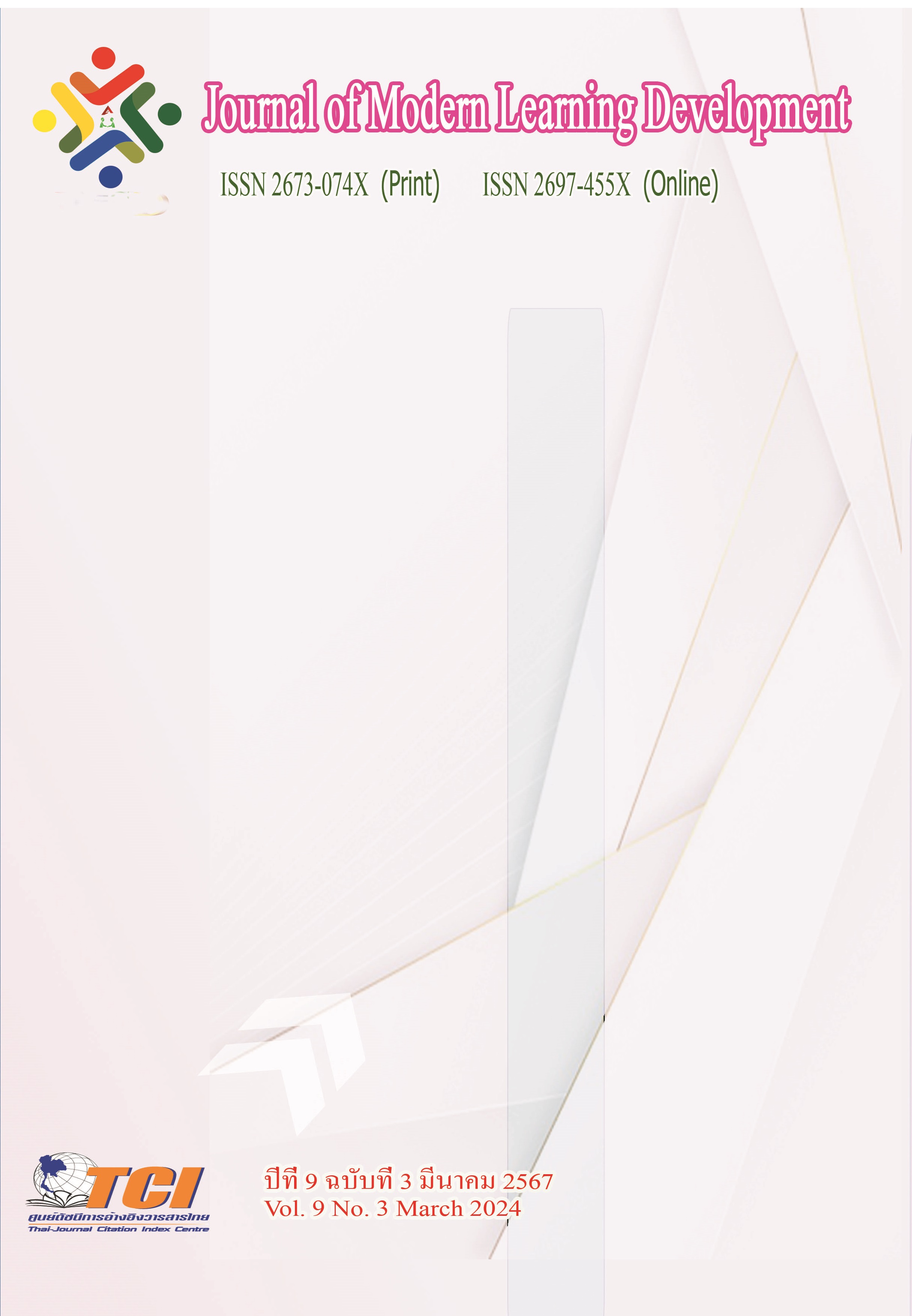Cultivation of Bodhicitta Based on the Slow Tourism Activities in Buddhist Approach
Main Article Content
Abstract
This article aims to present into 3 issues: concept of slow tourism, concept of Bodhicitta in Mahayana Buddhist Scriptures and guidelines to cultivate of Bodhicitta based on the slow tourism activities in Buddhist approach. Found that, 1) slow tourism is a kind of alternative tourism which is quality one in trend. It emphasizes on travel without hesitation for relaxing, learning, experience creating and do not cause any impact on the environment and society. There are 5 forms of slow tourism activities: (1) touching nature, (2) experience community's way of life, (3) undertaking creative activities, (4) low-carbon traveling, and (5) realizing value of life. 2) Bodhicitta means the mind of enlightenment. In inscriptions of Mahayana Buddhism believed that all being have enlightenment’s mind can cultivate and practice to enlighten, likewise setting right and straight mind with no adherence or Śūnyatā. By following to Bodhisattva's aspirations which are 6 Perfections and 3 characteristics 3) The guidelines to cultivate of Bodhicitta based on the slow tourism activities in Buddhist approach. There are activities guidelines to develop bodhicitta in the form of tourism activities that can contribute to the mental development into the original mind or the original home of the mind. This is the Bodhicitta resides in all beings according to Mahayana beliefs, in the model of “HOME Model”.
Article Details
References
กมลวรรณ วิชัยรัตน์. (2565). แนวคิดของ Slow Tourism เที่ยวช้าๆ ค่อยๆ เยียวยาใจ. ออนไลน์. สืบค้นเมื่อ 1 ธันวาคม 2565. แหล่งที่มา https://tonkit360.com/101203.
การท่องเที่ยวแห่งประเทศไทย. (2020). Slo-Mo-Go Around. ออนไลน์. สืบค้นเมื่อ 25 มีนาคม 2565 https://tatacademy.com/th/articles/article/f8464b1e
คณะกรรมการนโยบายการท่องเที่ยวแห่งชาติ. (มปป.) แผนพัฒนาการท่องเที่ยวแห่งชาติ พ.ศ. 2564-2565. (จัดทำและเผยแพร่โดย สำนักงานปลัดกระทรวงการท่องเที่ยวและกีฬา).
ชลดรงค์ ทองสง. (2558). แนวคิดการพัฒนา Slow Tourism ในประเทศไทย. วารสารวิทยาการวิจัยและวิทยาการปัญญา. 12 (2), 1-12.
ธัมมนันทา สามเณี (แปลจากอังกฤษเป็นไทย). (2545). วัชรเฉทิกปรัชญาปารมิตาสูตร. กรุงเทพมหานคร: เรือนแก้วการพิมพ์.
บุณยสฤษฎ์ อเนกสุข. (2560). การท่องเที่ยวเนิบช้า (Slow Tourism): นิยามและแนวคิด Slow Travel : A Concept Survey. วารสารมนุษยศาสตร์และสังคมศาสตร์. 8 (1), 26-47.
พระกุมารชีวะ. (2564). พระสัทธรรมปุณฑริกสูตร อวโลกิเตศวรโพธิสัตวสมันตมุขปริวรรต. (กนกพร นุ่มทอง และเกวลี เพชราทิพย์ แปล). กรุงเทพมหานคร: ศูนย์การแปลคัมภีร์พุทธศาสตร์ไทย-จีน มูลนิธิพุทธรังสี.
พระมหาสายัณห์ วิสุทโธ (เทียนครบ), พระมหามิตร ฐิตปญฺโญ, โสวิทย์ บำรุงภักดิ์ และธีระพงษ์ มีไธสง. (2561). โพธิจิตในพระพุทธศาสนามหายาน: ศึกษาวิเคราะห์บนฐานพระพุทธศาสนายุคต้น. วารสารวิชาการธรรมทรรศน์. 18 (3), 337-349.
วัชรภรณ์ สุรภี และ ฉลองศรี พิมลสมพงศ์. (2560). การพัฒนาแหล่งท่องเที่ยวแบบเนิบช้าในเอเชียตะวันออกเฉียงใต้ กรณีศึกษาเมืองน่าน ประเทศไทย และเมืองหลวงพระบาง ประเทศ สปป.ลาว. วารสารเทคโนโลยีภาคใต้. 10 (1), 1-9.
ศานติเทวะ. (2559). โพธิจรรยาวตารของศานติเทวะ. ออนไลน์. สืบค้นเมื่อ 22 ธันวาคม 2565. แหล่งที่มา: https://blog.thai-sanscript.com/benefits_bodhicitta
สุมาลี มหณรงค์ชัย. (2550). พุทธศาสนามหายาน. (พิมพ์ครั้งที่ 2). กรุงเทพมหานคร: ศยาม.
สุวิญ รักสัตย์. (2555). พระพุทธศาสนามหายาน. กรุงเทพมหานคร: บางกอกบล็อก.
เสถียร โพธินันทะ. (2543). ประวัติศาสตร์พระพุทธศาสนา. (พิมพ์ครั้งที่ 4). นครปฐม: โรงพิมพ์มหามกุฏราชวิทยาลัย.
เสถียร โพธินันทะ. (2548). ปรัชญามหายาน. (พิมพ์ครั้งที่ 5). นครปฐม: โรงพิมพ์มหามกุฏราชวิทยาลัย.
เสถียร โพธินันทะ. (2552). วิมลเกียรตินิเทสสูตร. (พิมพ์ครั้งที่ 9).นครปฐม: โรงพิมพ์มหามกุฏราชวิทยาลัย.
อภิชัย โพธิ์ประสิทธิ์ศาสต์. (2539). พระพุทธศาสนามหายาน. (พิมพ์ครั้งที่ 4). กรุงเทพมหานคร: สภาการศึกษามหามกุฏราชวิทยาลัย.
Dickinson, J.E., Lumsdon, L. & Robbins, D. 2011. Slow travel: issues for tourism and climate change. Journal of Sustainable Tourism. 19 (3), 281-300.
Nagarjuna’s Bodhicittavivarana. (2023). Bodhicittavivarana Exposition of Bodhicitta attributed to Nagarjuna (a critique of Vijnanavada). Online. Retrieved January 2, 2023. From: http://web.mit.edu/metta/www/readings/ nagarjuna_bodhicittavivarana_ verses.pdf.
Samye Institute. (2022). Bodhichitta. Online. Retrieved January 2, 2023. from https:// samyeinstitute.org/wiki/bodhichitta.
Shanti Deva. (2022). The Bodhicaryavatara of Santidev. Online. Retrieved January 2, 2023. from https://shantideva.net.
Ven. Gayleg Tenzin, Phramaha Anon Ānando, Asst. Prof. Dr.. 2019. The Concept of Bodhicitta in Mahāyāna Sūtras. The Journal of International Association of Buddhist Universities. 12 (1), 55-66.


